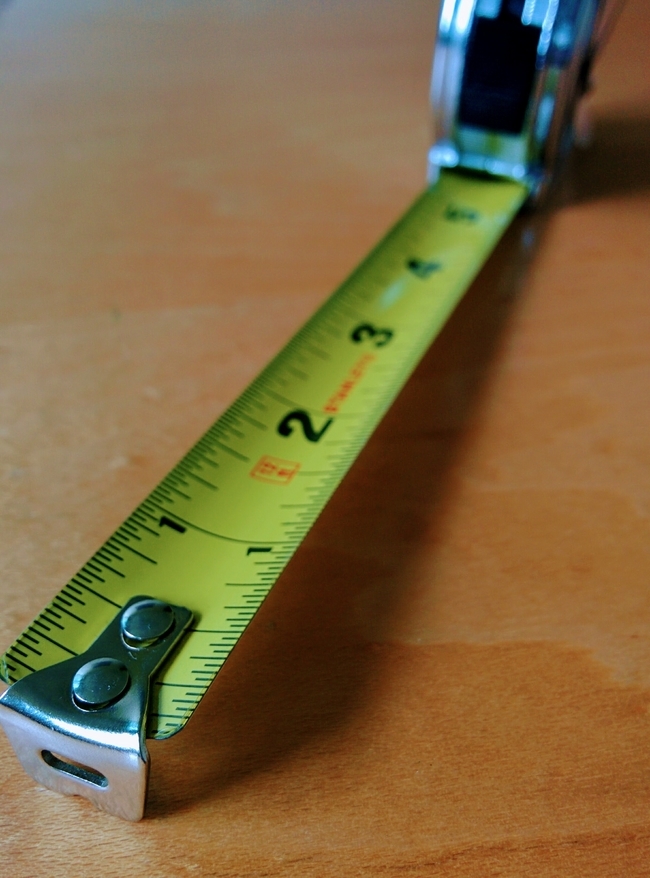
Measuring Tape
Measuring tapes are used in almost every type of construction. They come in different shapes and sizes. First, we will discuss a few basics about various kinds of measuring tapes and then we will discuss what to look for when deciding on a measuring tape to use when hanging drywall.
General guidelines for measuring tapes
The first thing to consider is the precision needed. For example, when doing finished carpentry such as cabinetry or wood trim work, it is important to be able to measure to at least one-sixteenth or even one-thirty-second of an inch. When doing rough carpentry such as wood framing or structural work such as concrete footings, usually one-eighth of an inch precision is sufficient and sometimes you can get away with one-quarter of an inch.
The next important thing to consider with measuring tapes is the total length needed. If you are doing surveying or engineering you may need an open reel measuring tape that can be 300 feet or more. There are also measuring wheels that can measure indefinitely and accommodate uneven terrain. For most interior construction work, no more than 30-foot-long measuring tapes are needed. Although many measuring tapes come in 25 or 30-foot lengths, some jobs are more easily accomplished with shorter 12 or 16-foot-long measuring tapes.Longer is not always better.
Another important factor to consider when looking for a measuring tape is the durability of the actual tape or blade. When a measuring tape fails, most often it develops a small tear within 1 foot of the hook on the end. The tear gradually widens and eventually the tape rips. A thick durable tape resists tears and will hold up well over time. Closely related to durability is the ability to stand out straight. If a tape is rated for 10 feet of blade stand-out that means you can hold the tape in front of you and the blade can be extended 10 feet before bending under its weight. This is a very useful feature when you are trying to get measurements by yourself. Without someone to hold the other end of the tape, you have to find some way to stand on one end of the room and hold the tape out as far as you can to measure to some point away from you. When it comes to standout length, the longer the better, and generally this means the thicker, more durable a tape is, the more standout length it has.
Novice carpenters may look at the hook on the end of a measuring tape and wonder why it is always loose. Some even go to the trouble of crimping the rivets that hold the hook to the blade, thus preventing the hook from moving. The hook is made to move in and out slightly. This movement accounts for the thickness of the hook, enabling you to measure inside or outside measurements and get an accurate measurement. Generally speaking, the hook should be able to move back and forth exactly the width of the hook itself. When measuring inside corners, the hook slides in toward the one-inch mark, so that the combined distance from the corner to the one-inch mark is exactly one inch taking into consideration the thickness of the hook. Conversely, when measuring outside corners, the hook slides out giving you an exact measurement from the end of the material, not from the end of the hook.
Another feature that differentiates certain types of measuring tapes from one another is the way the mechanism for locking the blade in place. Some have a sliding lock that crimps down on the blade to hold it in place. Others have a toggle button that prevents the reel from moving. Some blades have hooks specifically designed for certain tasks. For example, some hooks have magnetic ends. These are useful when working with steel studs or other metal materials.
What are some important features to look for when buying a measuring tape for hanging drywall? As to precision, no more than one-eighth of an inch of precision is necessary for drywall hanging. It is good, however, to be able to measure to a sixteenth of an inch. Most measurements are taken in eighths and when more precision is needed for a particular cut the measurement is usually described as eighths heavy or light. For example, thirty-two and five-eights heavy is the same as thirty-two and eleven-sixteenths.
Sheets of drywall are available in a variety of lengths. Most commonly, 8 to 12-foot lengths are used. When the longest material being measured is 12 feet in length, it is not necessary to have a measuring tape longer than 16 feet long. Occasionally you may find it convenient to be able to measure longer distances in a room, especially when determining your initial layout, and for this, you may find it necessary to have a 25 or 30-foot-long measuring tape. However, a 16-foot measuring tape has some advantages for hanging drywall. Shorter measuring tapes are smaller and easier to hold. A small tape comes in handy when ripping sheets horizontally. To do so you have to hold the tape in one hand while using your index finger as a guide sliding along the edge of the board. The other hand holds a utility knife to score the paper. Many experienced drywall hangers have found they prefer having a sturdy 16-foot tape for day-to-day use and a longer 30-foot tape that they leave in their toolbox for occasional use.
Tips for buying a measuring tape for drywall hanging
Durability is very important for measuring tapes used by drywall hangers. Tapes are often used in conjunction with utility knives and therefore easily nicked. Drywall hanging creates a lot of dust so a durable tape reel with a solid locking mechanism is also a necessity. The standout length is of interest for drywall hanging. Many measurements are taken off a bench so it is nice to have a tape measure that can stand-out several feet without bending to be able to take some measurements without an assistant. Once these factors are met, it is good to consider the feel. As mentioned earlier, hanging drywall rarely requires longer than a 16-foot measuring tape. A small tape is more portable and since it is often in your left hand it is good to consider how it will feel after holding it in your left hand for hours at a time.
Buying measuring tapes need not be complicated. There are many options when it comes to measuring tapes. It is good to shop carefully since a measuring tape is used so frequently on the job.

